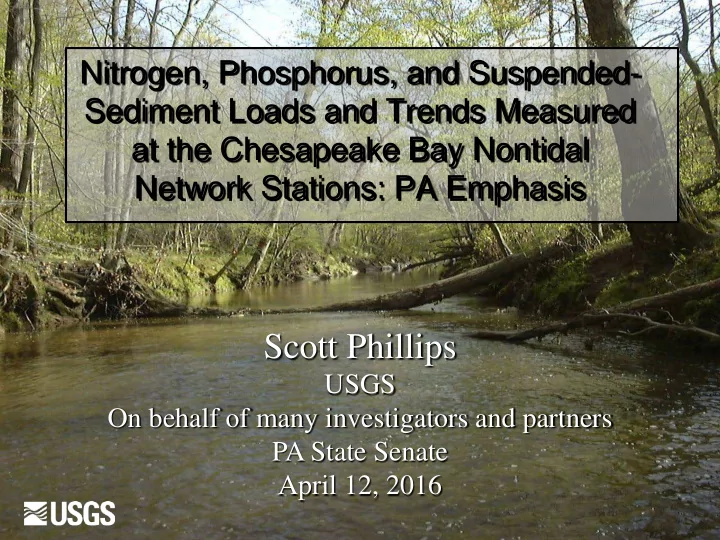

Nitrogen, Phosphorus, and Suspended- Sediment Loads and Trends Measured at the Chesapeake Bay Nontidal Network Stations: PA Emphasis Scott Phillips USGS On behalf of many investigators and partners PA State Senate April 12, 2016
Acknowledgements • Load and Trend Analysis Jeff Chanat Joel Blomquist Mike Mallonee Gavin Yang Ken Hyer Many Others!! Mike Langland Bob Hirsch • USGS Nontidal Web Page (http://cbrim.er.usgs.gov/) Cassandra Ladino Scott Phillips • Water-Quality Monitoring Partners U.S. Environmental Protection Agency NY State Dept. of Env. Conservation PA Dept. of Env. Protection Susquehanna River Basin Comm. DC Dept. of the Environment DE Dept. Natural Resources and Env. Control MD Dept. of Natural Resources VA Dept. of Env. Quality WV Dept. of Env. Protection U.S. Geological Survey (All Bay States) WV Dept. of Ag.
Measuring Water- Quality Improvements • Practices implemented – BMP reporting for TMDL – Predicted improvements (WSM) • Watershed monitoring – Nutrient and sediment – Loads and trends • Attaining standards – DO clarity/SAV, and Chl. • Explain: practices and water-quality changes
Chesapeake Bay Nontidal Monitoring Network • 1985: River-Input Monitoring and selected sites • 2004: agree on comparable methods • TMDL expansion • 117 stations – Range from 1 to 27,100 mi 2 – PA: 31 sites • Nutrient and sediment collected – Monthly and storms – Streamflow • Loads and trends computed • First of its’ kind
Load and Trends • Annual loads • Flow- normalized Annual Load change 1985 to 2014: 25% reduction down 25% 18% reduction 2005 to 2014: Flow-Normalized down 18% Load • Per acre loads
Results: N, P and Sediment • Loads – Per acre loads • Trends – Directional change – Amount of change
Total Nitrogen (loads per acre) Bay watershed • Range: 1.19 to 33.4 lbs/ac • Average: 7.33 lbs/ac PA results: • 3.3-33.4 lbs per acre • 11.5 lbs per acre • Highest in southern areas
Total Nitrogen Trends (2005-2014) Chesapeake Watershed • Improving Trends: 54% • Degrading Trends: 27% • No Trend: 19% PA: Majority improving • Improving: 14 • Degrading: 3 • No change: 1
Changes in Nitrogen per Acre Loads: 2005-2014 Susquehanna Watershed
Amount of Nitrogen Change (2005-2014) Improving Stations: Range = -0.10 to -5.07 lbs/ac Median = -0.68 lbs/ac (-10.0%) Degrading Stations: Range = 0.04 to 1.21 lbs/ac Median = 0.33 lbs/ac (7.84%) Differs by watershed
PHOSPHORUS 11
Total Phosphorus Loads and Trends: (2005-2014) Loads per acre • Above average in PA • Eastern part of basin Watershed: Majority improving • Improving: 68% • Degrading: 20% • No Trend : 12% PA trends: Similar trends
Changes in Phosphorus per Acre Loads: 2005-2014 Susquehanna Watershed
Amount of Phosphorus Change (2005-2014) Improving Stations Range = -0.014 to -1.08 lbs/ac Median = -0.11 lbs/ac (-24.7%) Degrading Stations Range = 0.007 to 0.43 lbs/ac Median = 0.07 lbs/ac (18.2%) Differ by watershed
Suspended Sediment Loads and Trends (2005-2014) Loads per acre • Range from 18 to 2,206 lbs/ac • Average load of 482 lbs/ac Trends: Mixed Results • Improving: 50% • Degrading: 30% • No Trend : 20% • PA similar
River Input Sites: Loads to tidal waters • Monitor 78% of watershed • 9 sites • Upstream from several urban areas and WWTPs • 3 basins dominate loading • Less improvement for N, P, and Sediment
Change in Total Nitrogen (9 RIM Stations) 2005-14 No trends: 2 (Susquehanna & James) Improving: 3 (Potomac) Degrading: 4
Changes in Total Phosphorus 9 RIM Stations 2005-14 Although the Susquehanna and Potomac Rivers carry the largest loads, all RIM stations have an Degrading: 4 influence on their respective (Susquehanna estuary. and James) Improving: 2 (Potomac) No trends: 3
1. What Works Explaining Trends – Upgrades to WWTPs – Reductions in air emissions – Some agricultural practices 2. Challenges – Response times – Development and intensified agriculture 3. What We Need – Location should guide restoration efforts – Stormwater management and monitoring • UMCES, USGS, EPA (2014)
PA Highlights • High loads per acre in some areas – Nitrogen: SE portion of basin – Phosphorus: eastern portion • Improving trends – Total Nitrogen and Phosphorus – Mixed Results for Sediment – WWTP, air, selected ag practices • Susquehanna Reservoirs counteracting improvements – TN: little change TP: worsening • Other Challenges: development, intensified ag, lag times
USGS Nontidal Web Page http://cbrim.er.usgs.gov/
Recommend
More recommend